
Article index
- 1 – Overview
- 2 – Gallery
- 3 – GPU information
- 4 – Benchmarks
- 4.1 – 3DMark FireStrike
- 4.2 – 3DMark TimeSpy
- 4.3 – 3DMark Port Royal
- 4.4 – 3DMark DX Raytracing Test
- 4.5 – 3DMark Speed Way
- 4.6 – Unigine Superposition
- 4.7 – FurMark
- 4.8 – Rhodium LC
- 5 – Burn-in Test
- 6 – Conclusion
1 – Overview
Radeon RX 7900 graphics cards have been launched in December 2022. More or less two months after I can finally test one of AMD’s new graphics weapons and update my GPU monitoring code for all my GPU tools. In this review, I will quickly test the performances of the RX 7900 XTX. I will post other articles with particular tests like Vulkan ray tracing.
The Nitro+ RX 7900 XTX is the flagship model of SAPPHIRE. The Nitro+ is a heavy card: 1.840 kg. This weight comes from the bulky 3-slot VGA cooler. Such a big cooler is required to dissipate the several hundred of watts of the whole graphics card. The VGA cooler runs quietly and has a lighting bar that can be customized.
The Radeon RX 7900 XTX is based on the new RDNA3 architecture implemented in the Navi 31 GPU. The graphics processing unit has 6144 dual-issue stream processors (dual issue means the output of stream processor is doubled over previous generation, that’s why you can see specifications with 12288 stream processors). The RX 7900 XTX has 96 compute units and 96 ray tracing units, 384 TMUs (texture management units) and 192 ROPs (render output units). The amount of graphics memory is also impressive: 24 GB of GDDR6 that dialogs with the CPU on a 384-bit memory bus. The total board power consumption of the reference model is 355W but for the Nitro+, this value is a bit higher: 420W and even more as we will see it in the burn-in section.
More marketing stuff and specifications can be found on the Nitro+ homepage.
2 – Gallery
The bundle includes the following items:
– the RX 7900 XTX Nitro+.
– a metallic bracket to support this heavy graphics card when installed horizontally in a case.
– a RGB cable to synchronize lighting effects with the motherboard.
– various installation guides.
The box:
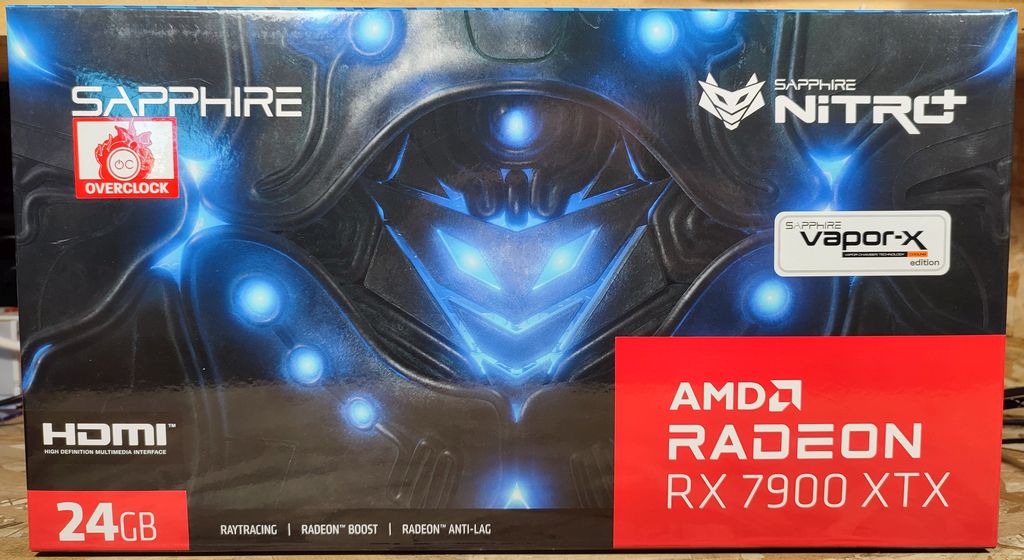
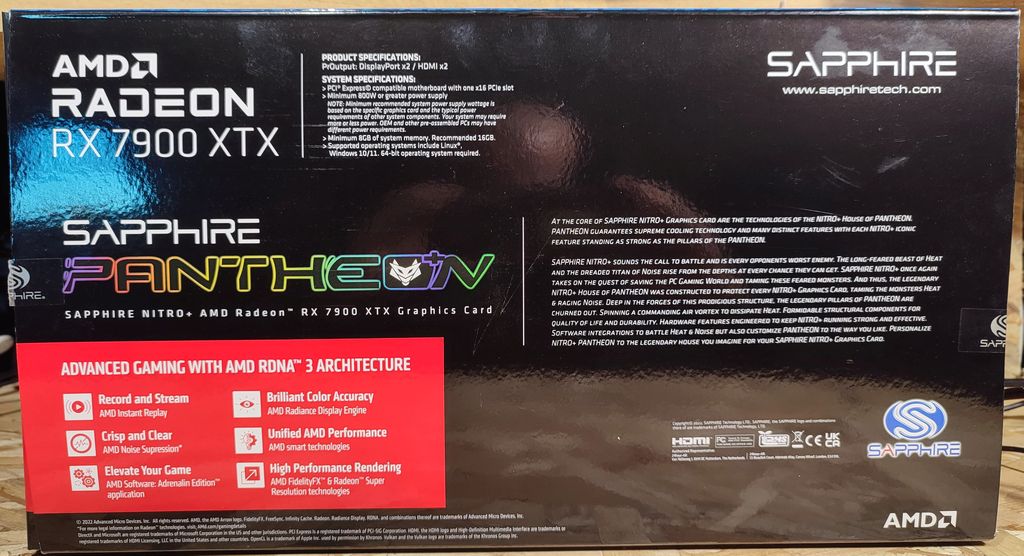
The accessories:
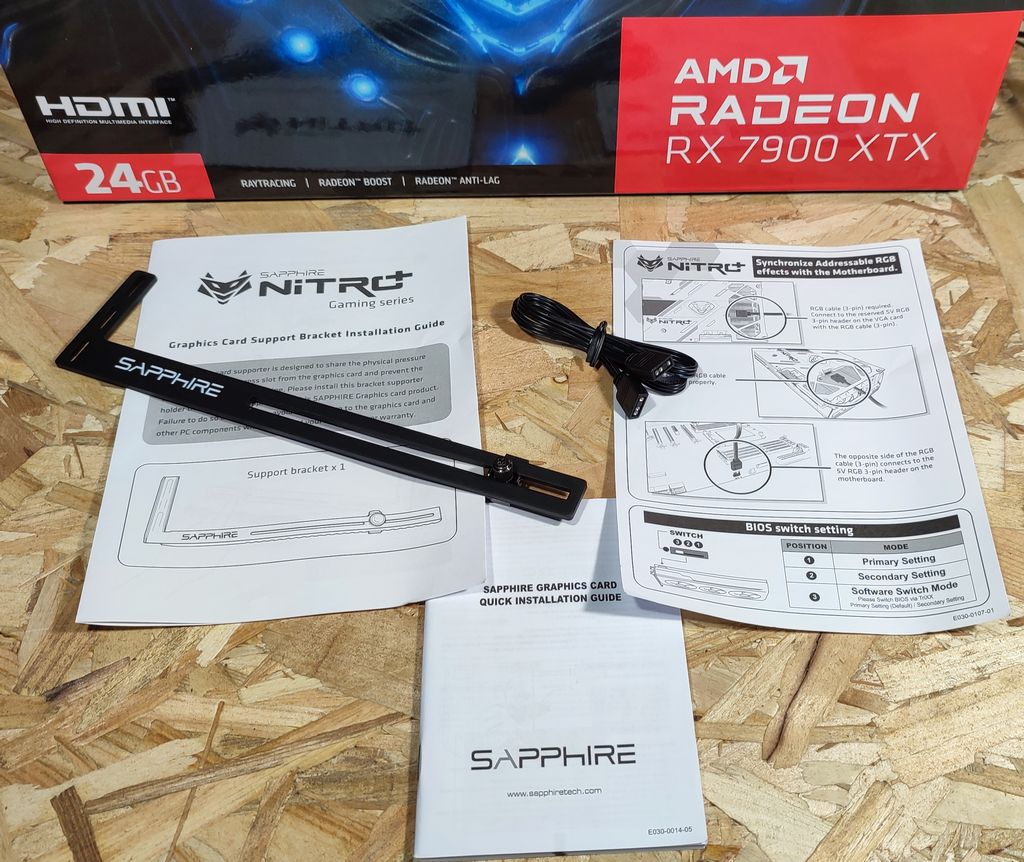
The Radeon RX 7900 XTX graphics card:

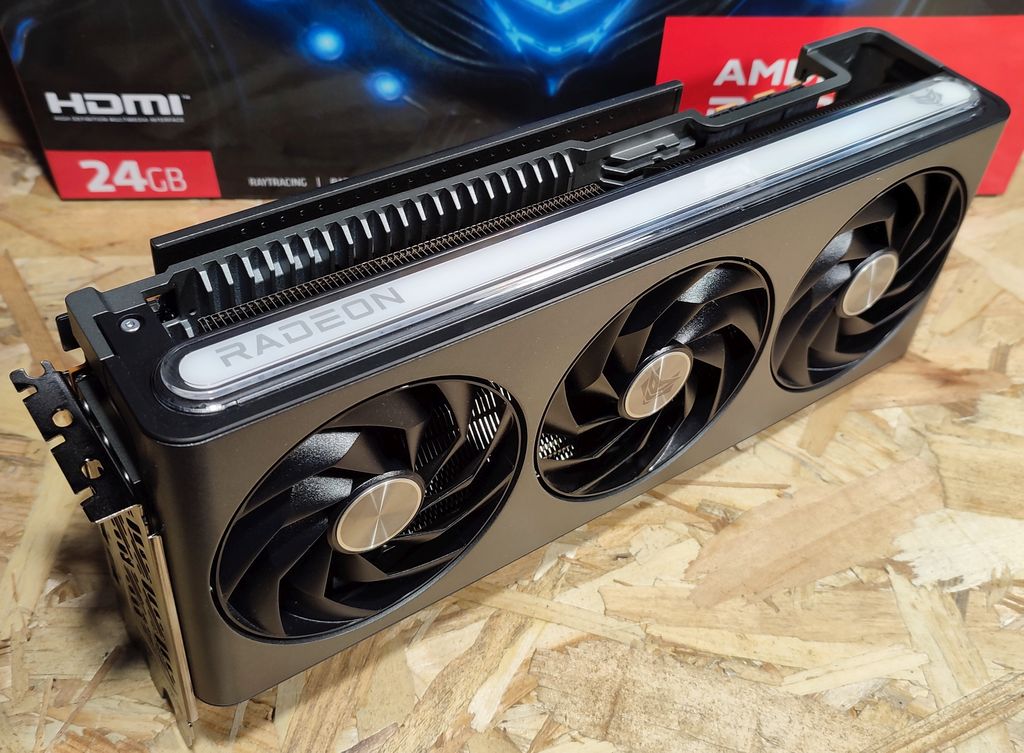

The Nitro+ RX 7900 XTX comes with three 8-pins power connectors. The total power consumption of the board can reach 525 W:
– 75 W (PCI-e bus)
– 3 x 150 W (one 8-pin = 150 W)
The total board power of the reference RX 7900 XTX is 355W. This Nitro+ model has a total board power a bit higher, and these three 8-pins are not here for decoration. See the burn-in part of the review.
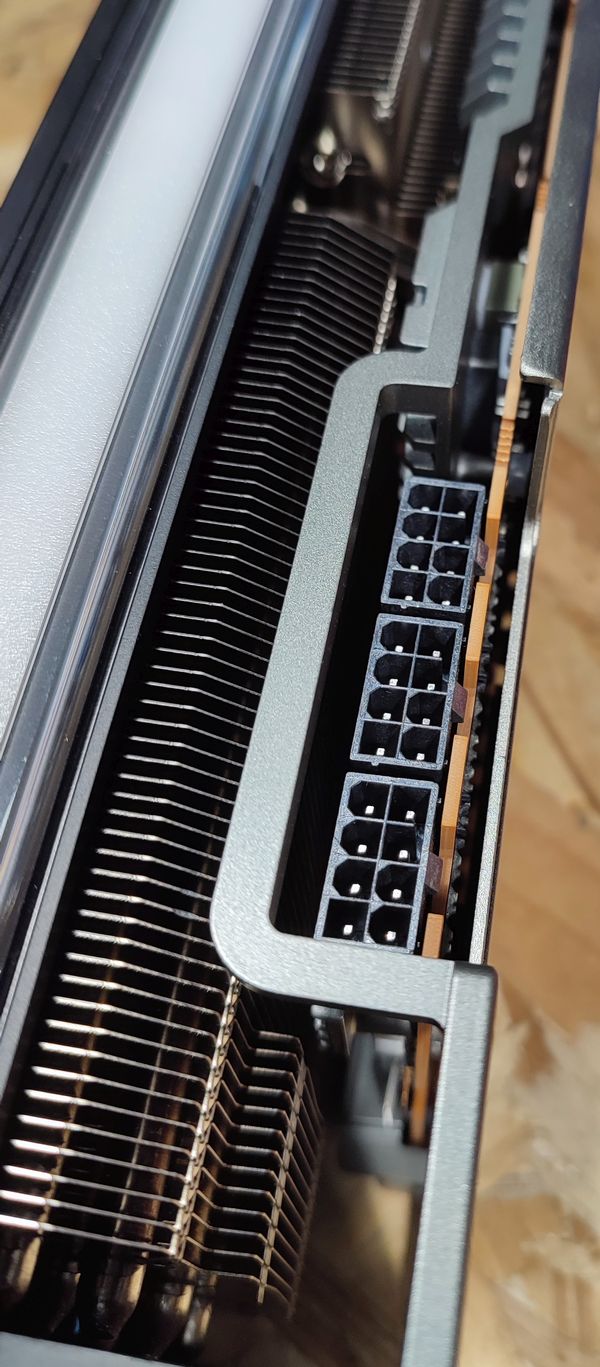
The three 10cm fans:

The rear side with a nice backplate:
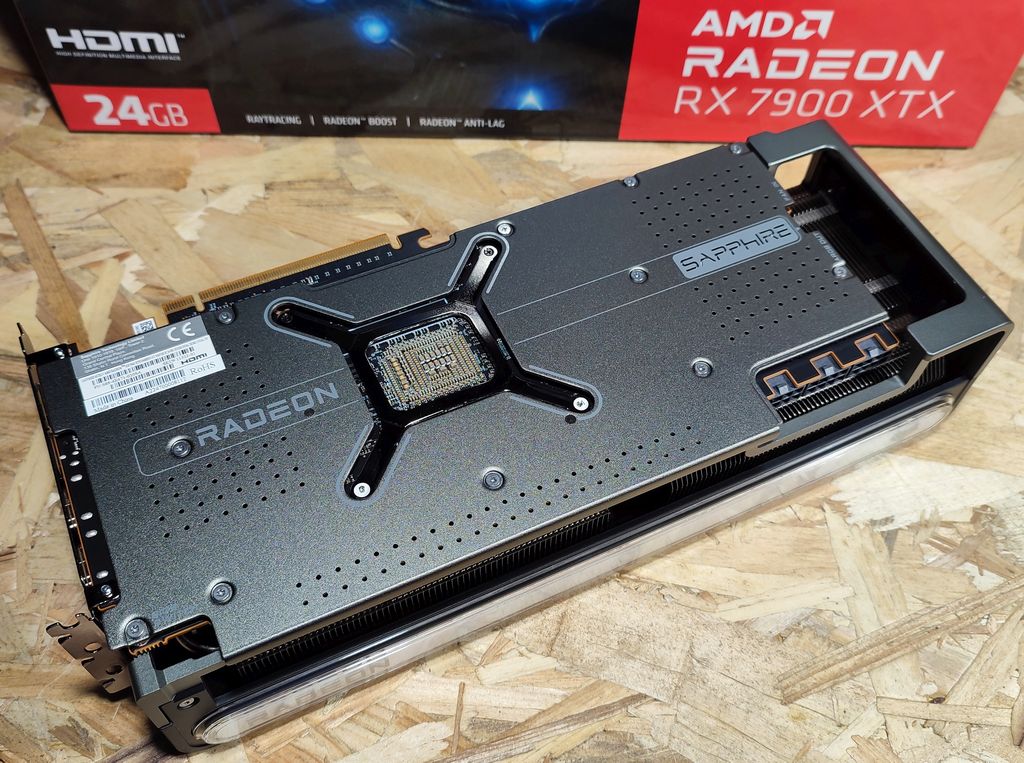
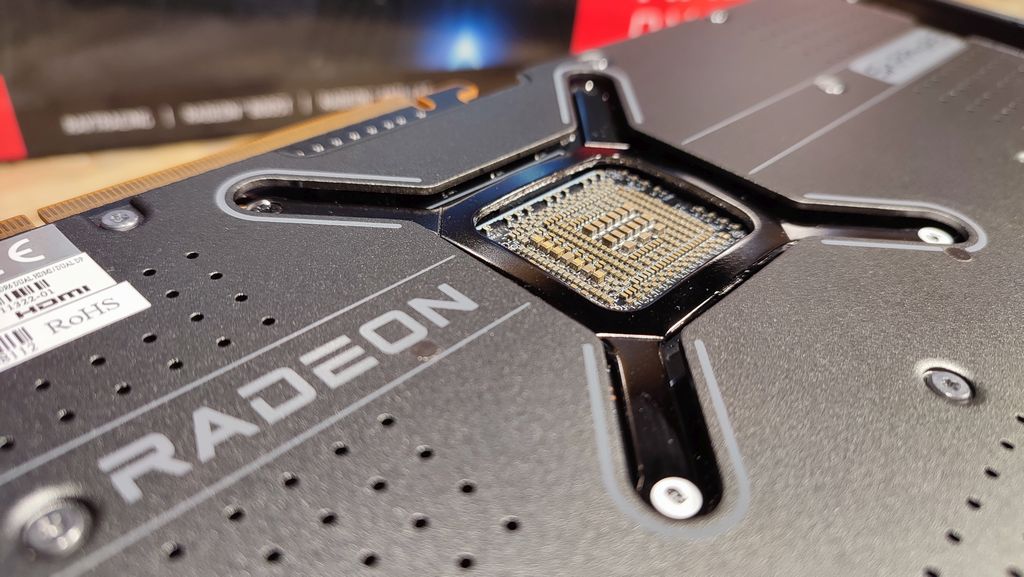

The BIOS switch: this switch allows to select three different BIOS:
1/ primary settings (higher performances)
2/ secondary settings (lower power limit)
3/ software switch mode: this mode allows to switch between primary and secondary settings using SAPPHIRE TriXX.

The output connectors: two HDMI 2.1 ports and two DisplayPort 2.1 ports.
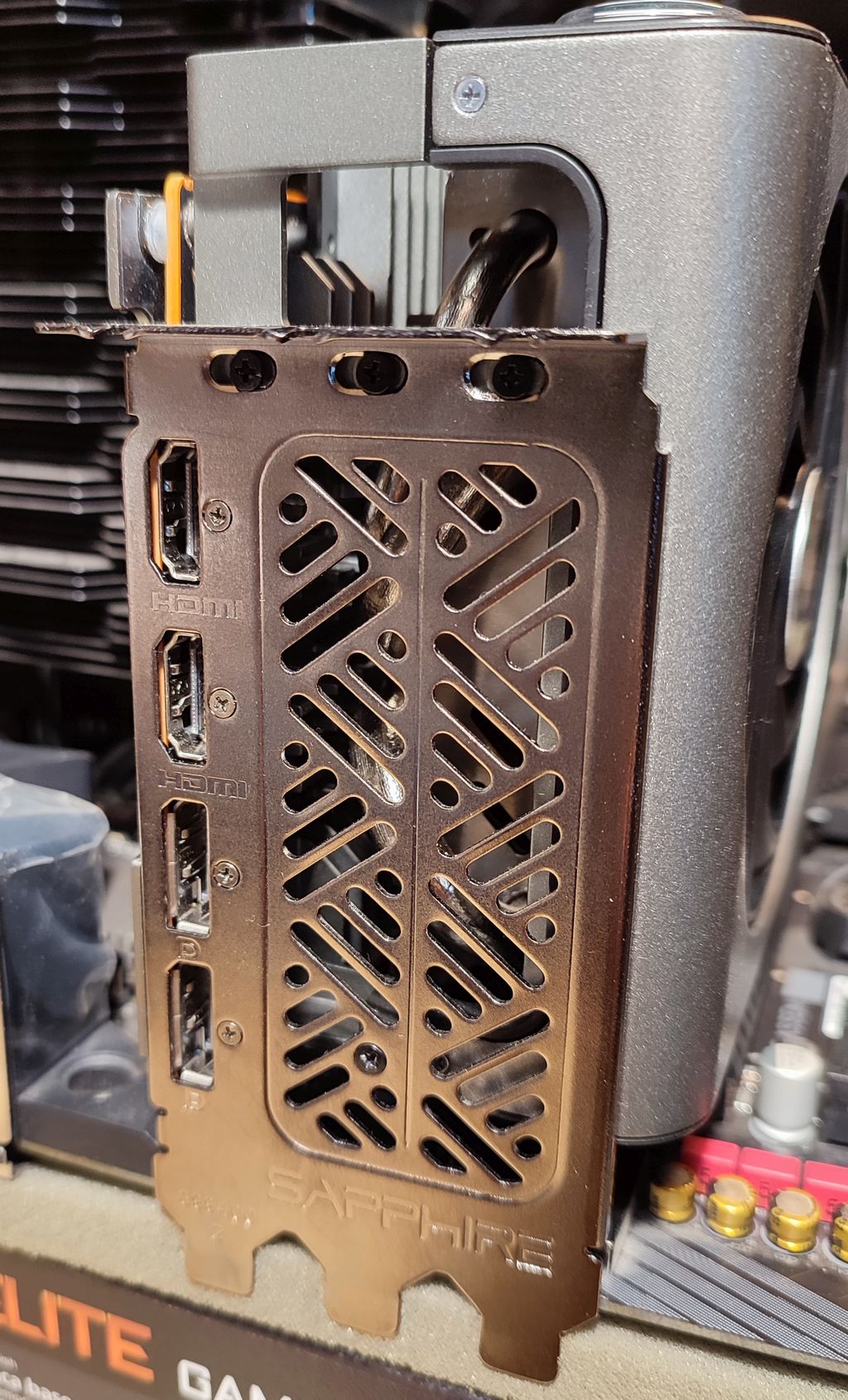
The ASUS TUF RX 6800 XT compared to the Nitro+ RX 7900 XTX:

The Nitro+ RX 7900 XTX has a lighting bar you can easily control via TriXX. Several modes are available:

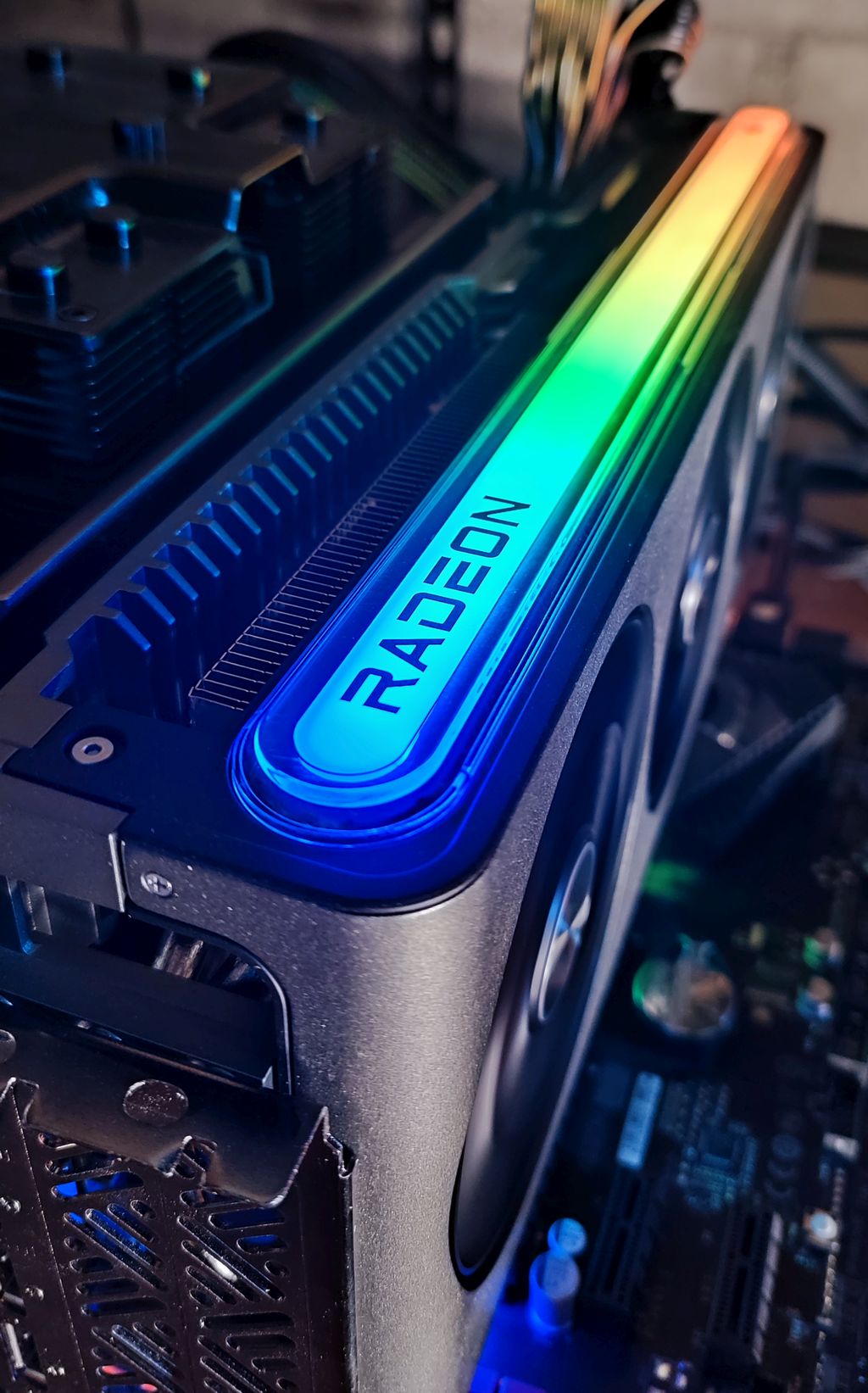

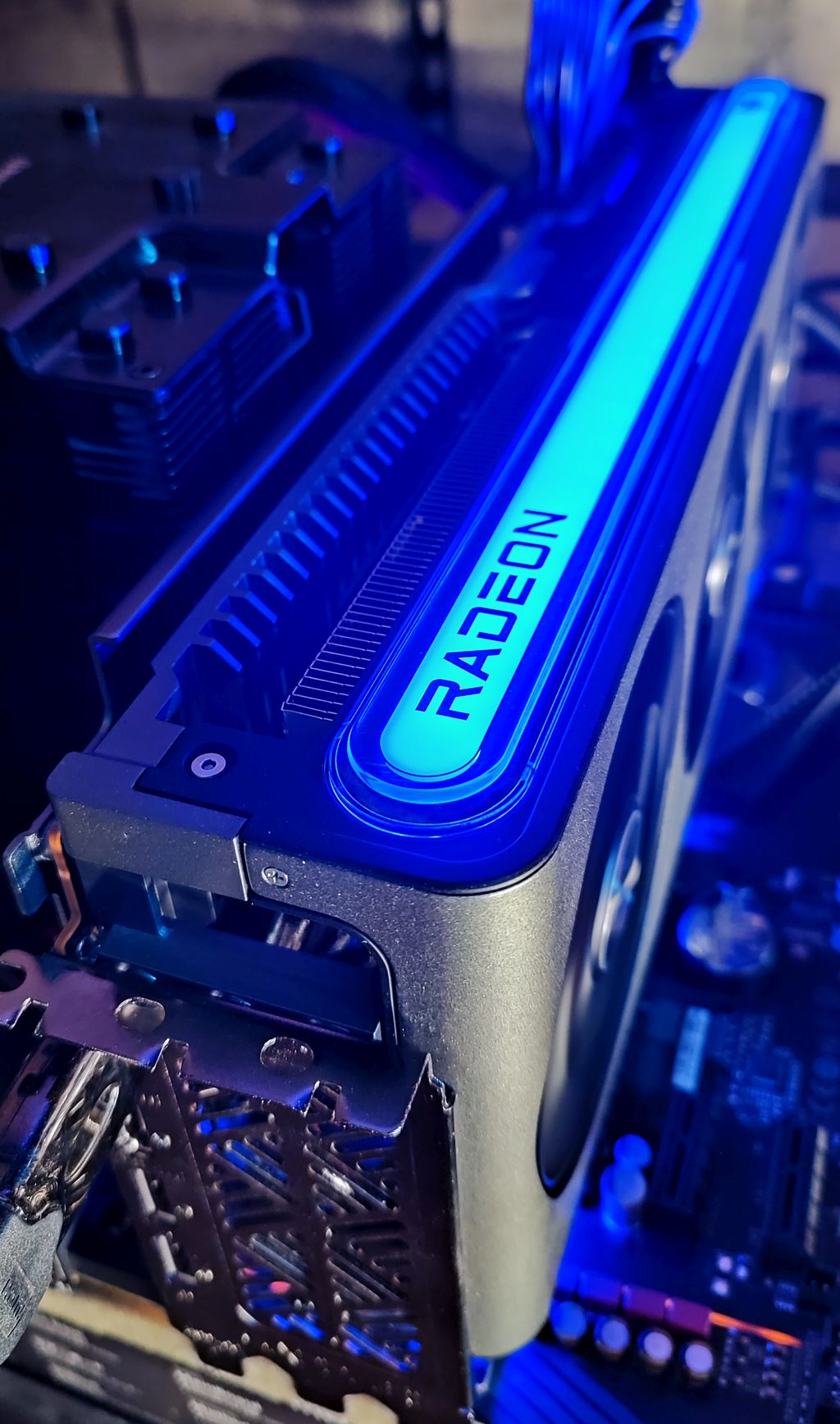
3 – GPU Information
GPU data from the new GPU Shark 2:
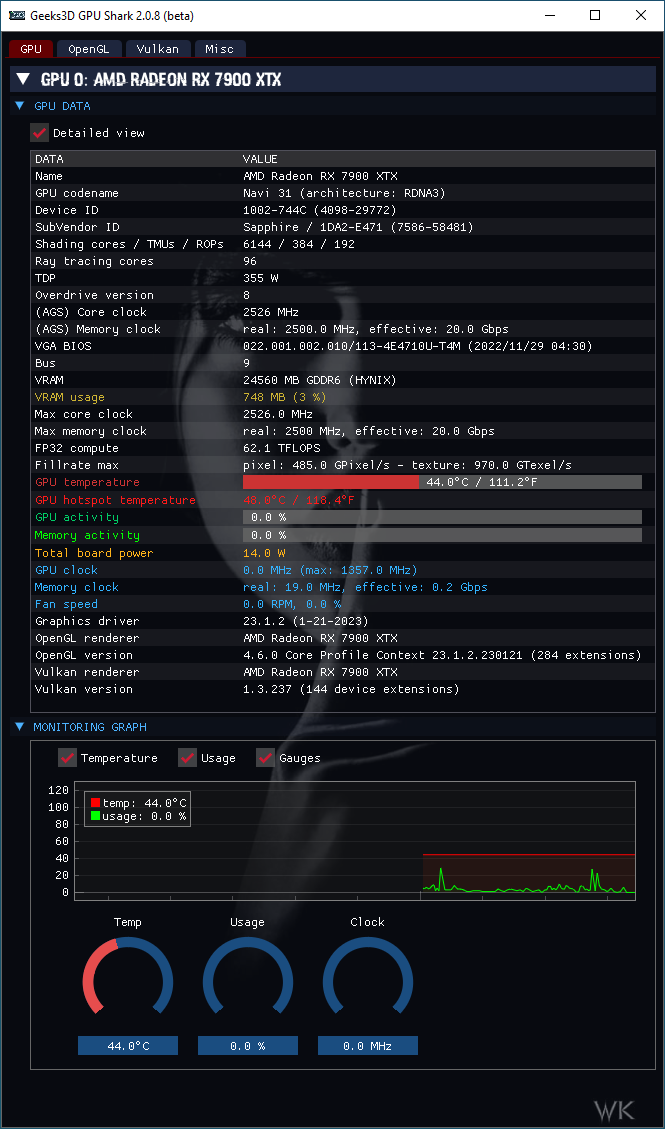
GPU-Z screenshots.
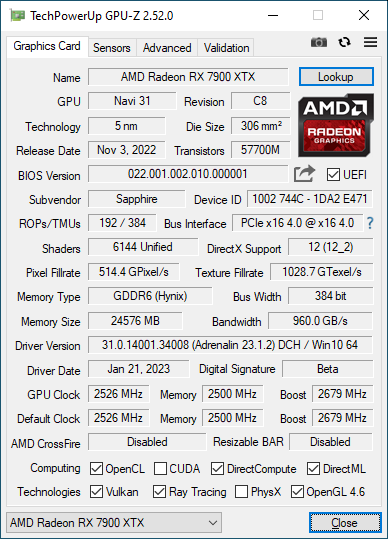
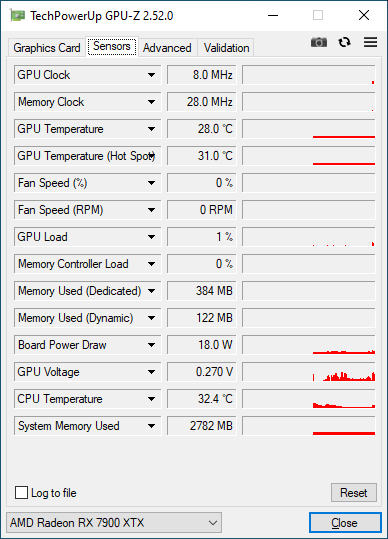
4 – GPU Benchmarks
| Arc A380 Test System 2 | |
|---|---|
| CPU | AMD Ryzen 7 5800X |
| Motherboard | ASUS TUF X570-Plus |
| Memory | 16GB DDR4 Corsair Vengeance LED @ 3200MHz |
| PSU | Corsair RM1000x |
| Storage | Samsung 860 EVO 1TB SSD |
| Monitor | ASUS TUF VG289Q 4K |
| OS | Windows 10 22H2 64-bit |
| Graphics driver | Radeon Adrenalin 23.1.2 |
4.1 – 3DMark FireStrike
Fire Strike is a DirectX 11 benchmark for high-performance gaming PCs and overclocked systems. Fire Strike is very demanding, even for the latest graphics cards. If your frame rate is low, use Sky Diver instead.
Graphics test 1 has heavy tessellation and volumetric illumination. Graphics test 2 features complex smoke simulation using compute shaders on the GPU and dynamic particle illumination.
The Physics test runs 32 parallel simulations of soft and rigid body physics on the CPU.
The Combined test includes tessellation, illumination, smoke simulation and particles and post-processing on the GPU, while the CPU is tasked with running 32 parallel physics simulations.
Firestrike has a global score and three sub-scores (graphics, physics and combined). For this test, I compare the graphics score only.
| 77375 SAPPHIRE Nitro+ Radeon RX 7900 XTX 24GB – Adrenalin 23.1.2 |
| 48432 ASUS TUF Radeon RX 6800 XT OC 16GB – Adrenalin 20.12.2 |
| 31431 Intel Arc A750 LE – Intel 31.0.101.3793 – Resizable BAR: ON |
| 29130 GIGABYTE GeForce RTX 3060 Ti Gaming OC 8G – GeForce 460.79 |
| 13079 EVGA GeForce GTX 1060 SC 6GB – GeForce 416.94 |
| 11368 MSI GeForce GTX 970 – GeForce 416.94 |
| 9402 ASRock Arc A380 – Intel 31.0.101.3491 |
| 8616 MSI Radeon HD 7970 – Adrenalin 18.11.1 |
4.2 – 3DMark TimeSpy
Time Spy is a DirectX 12 benchmark with native support for new API features like asynchronous compute, explicit multi-adapter, and multi-threading.
Time Spy Graphics tests are rendered at 2560 × 1440 resolution.Graphics test 1 features lots of transparent content, particle shadows, and tessellation. Graphics test 2 features ray-marched volumetric illumination
with hundreds of lights and a large number of small particles.
Same thing, I took the graphics score only.
| 29930 SAPPHIRE Nitro+ Radeon RX 7900 XTX 24GB – Adrenalin 23.1.2 |
| 16294 ASUS TUF Radeon RX 6800 XT OC 16GB – Adrenalin 20.12.2 |
| 12264 Intel Arc A750 LE – Intel 31.0.101.3793 – Resizable BAR: ON |
| 10837 GIGABYTE GeForce RTX 3060 Ti Gaming OC 8G – GeForce 460.79 |
| 10415 ASUS ROG Strix GeForce RTX 2080 OC 8GB – GeForce 460.89 |
| 8461 MSI GeForce RTX 2070 Ventus 8GB – GeForce 417.01 |
| 4776 SAPPHIRE Radeon RX 5500 XT Pulse – Adrenalin 20.01.3 |
| 4334 ASRock Arc A380 – Intel 31.0.101.3491 – Resizable BAR: OFF |
| 4301 ASRock Arc A380 – Intel 31.0.101.3491 – Resizable BAR: ON |
| 4244 EVGA GeForce GTX 1060 SC 6GB – GeForce 416.94 |
| 753 Intel UHD Graphics 770 – Intel 31.0.101.1371 |
4.3 – 3DMark Port Royal
Port Royal is a graphics card benchmark for testing real-time ray tracing performance. To run this test, you must have a graphics card and drivers that support Microsoft DirectX Raytracing.
The test measures graphics card performance with a combination of real-time ray tracing and traditional rendering techniques. The scene features ray traced reflections, shadows (ray traced and shadow mapped), glass surfaces with ray traced reflections, volumetric lighting, particles, and post-processing effects. The rendering resolution is 2560 × 1440.
| 15816 SAPPHIRE Nitro+ Radeon RX 7900 XTX 24GB – Adrenalin 23.1.2 |
| 9149 ASUS TUF Radeon RX 6800 XT OC 16GB – Adrenalin 20.12.2 |
| 6916 GIGABYTE GeForce RTX 3060 Ti Gaming OC 8G – GeForce 460.79 |
| 6512 Intel Arc A750 LE – Intel 31.0.101.3793 – Resizable BAR: ON |
| 6863 ASUS ROG Strix GeForce RTX 2080 OC 8GB – GeForce 460.89 |
| 745 ASRock Arc A380 – Intel 31.0.101.3491 – Resizable BAR: ON |
| 666 ASRock Arc A380 – Intel 31.0.101.3491 – Resizable BAR: OFF |
4.4 – 3DMark DX Raytracing Test
The DirectX Raytracing feature test measures pure ray-tracing performance. Use this test to compare the performance of dedicated ray-tracing hardware in the latest graphics cards.
In this feature test, there is a minimal amount of traditional rendering. The result of the test depends entirely on the ray-tracing performance of the graphics card.
Instead of using traditional rendering, the whole scene is ray-traced and drawn in one pass. Camera rays are traced across the field of view with small random offsets to simulate a depth of field effect. The frame rate is determined by the time taken to trace and shade a set number of samples for each
pixel (12 samples per pixel), combine the results with previous samples and present the output on the screen. The rendering resolution is 2560 × 1440.

| 51.86 SAPPHIRE Nitro+ Radeon RX 7900 XTX 24GB – Adrenalin 23.1.2 |
| 28.78 FPS Intel Arc A750 LE – Intel 31.0.101.3793 – Resizable BAR: ON |
| 27.43 GIGABYTE GeForce RTX 3060 Ti Gaming OC 8G – GeForce 522.25 |
| 25.25 FPS ASUS TUF Radeon RX 6800 XT OC 16GB – Adrenalin 22.10.1 |
| 21.5 FPS ASUS ROG Strix GeForce RTX 2080 OC 8GB – GeForce 522.25 |
| 9 FPS ASRock Arc A380 – Intel 31.0.101.3491 |
4.5 – 3DMark Speed Way
3DMark Speed Way is a graphics card benchmark for testing DirectX 12 Ultimate performance. To run this test, you must have a graphics card that supports DirectX 12 Ultimate and has 6GB or more of video memory.
Graphics test: the test measures graphics card performance with a combination of real-time ray tracing and traditional rendering techniques. The scene features ray traced reflections, real time global illumination, mesh shaders, volumetric lighting, particles and post-processing effects. The rendering resolution is 2560 × 1440.

| 6294 SAPPHIRE Nitro+ Radeon RX 7900 XTX 24GB – Adrenalin 23.1.2 |
| 3433 (avg FPS: 34) ASUS TUF Radeon RX 6800 XT OC 16GB – Adrenalin 22.10.1 |
| 2970 (avg FPS: 29) GIGABYTE GeForce RTX 3060 Ti Gaming OC 8G – GeForce 522.25 |
| 2320 (23.2 FPS) Intel Arc A750 LE – Intel 31.0.101.3793 – Resizable BAR: ON |
| 2168 (avg FPS: 21) ASUS ROG Strix GeForce RTX 2080 OC 8GB – GeForce 522.25 |
| 434 (avg FPS: 4) ASRock Arc A380 6GB – Resizable BAR: ON – Intel 31.0.101.3491 |
| 375 (avg FPS: 3) ASRock Arc A380 6GB – Resizable BAR: OFF – Intel 31.0.101.3491 |
4.6 – Unigine Superposition – 1080p Medium – Direct3D
| 38879 (avg FPS: 290) SAPPHIRE Nitro+ Radeon RX 7900 XTX 24GB – Adrenalin 23.1.2 |
| 21154 (avg FPS: 175) GIGABYTE GeForce RTX 3060 Ti Gaming OC 8G – GeForce 460.79 |
| 20985 (avg FPS: 157) ASUS TUF Radeon RX 6800 XT OC 16GB – Adrenalin 20.12.2 |
| 20923 (156 FPS) Intel Arc A750 LE – Intel 31.0.101.3793 – Resizable BAR: ON |
| 9082 (avg FPS: 67.9) EVGA GeForce GTX 1060 SC 6GB – GeForce 416.94 |
| 7166 (avg FPS: 53) ASRock Arc A380 – Intel 31.0.101.3491 – Resizable BAR: ON |
| 6141 (avg FPS: 46) ASRock Arc A380 – Intel 31.0.101.3491 – Resizable BAR: OFF |
4.7 – FurMark 1.33
FurMark is a very intensive graphics benchmark and does not depend on the processing power of the CPU. So FurMark is a quick way to have an overview of the graphics performances of a GPU.
P1080 (1920×1080)
| 27719 (453 FPS) SAPPHIRE Nitro+ Radeon RX 7900 XTX 24GB – Adrenalin 23.1.2 |
| 17507 (avg FPS: 292) ASUS TUF Radeon RX 6800 XT OC 16GB – Adrenalin 20.12.2 |
| 10530 (avg FPS: 175) GIGABYTE GeForce RTX 3060 Ti Gaming OC 8G – GeForce 460.79 |
| 10137 (169 FPS) Intel Arc A750 LE – Intel 31.0.101.3793 – Resizable BAR: ON |
| 7322 (avg FPS: 122) ASUS ROG Strix GeForce GTX 1080 OC 8GB – GeForce 416.94 |
| 4556 (avg FPS: 76) EVGA GeForce GTX 1060 SC 6GB – GeForce 416.94 |
| 4475 (avg FPS: 75) SAPPHIRE Radeon RX 5500 XT Pulse – Adrenalin 20.01.3 |
| 3246 (avg FPS: 54) MSI Radeon HD 7970 – Adrenalin 18.11.1 |
| 3036 (avg FPS: 50) ASRock Arc A380 – Intel 31.0.101.3491 – Resizable BAR: ON |
| 2969 (avg FPS: 49) ASRock Arc A380 – Intel 31.0.101.3491 – Resizable BAR: OFF |
| 714 (avg FPS: 12) Intel UHD Graphics 770 – Intel 31.0.101.1371 |
4.8 – Rhodium LC
Rhodium LC (LC for Liquid Carbon!) is a new GPU pixel shader benchmark made with GeeXLab and based on this shadertoy demo. You can download RhodiumLC from THIS PAGE.

P1080 (1920×1080)
| 17026 (283 FPS) SAPPHIRE Nitro+ Radeon RX 7900 XTX 24GB – Adrenalin 23.1.2 |
| 6189 (103 FPS) Intel Arc A750 LE – Intel 31.0.101.3793 – Resizable BAR: ON |
| 5740 (avg FPS: 95) ASUS TUF Radeon RX 6800 XT OC 16GB – Adrenalin 20.12.2 |
| 4853 (avg FPS: 80) ASUS ROG Strix GeForce RTX 2080 OC 8GB – GeForce 416.94 |
| 4094 (avg FPS: 68) GIGABYTE GeForce RTX 3060 Ti Gaming OC 8G – GeForce 526.98 |
| 2835 (avg FPS: 47) EVGA GeForce GTX 1070 FTW – GeForce 416.94 |
| 2773 (avg FPS: 46) ASUS Strix Radeon RX 5700 – Adrenalin 20.12.2 |
| 1923 (avg FPS: 32) EVGA GeForce GTX 1060 SC 6GB – GeForce 416.94 |
| 1755 (avg FPS: 29) SAPPHIRE Radeon RX 5500 XT Pulse – Adrenalin 20.01.3 |
| 1719 (avg FPS: 28) ASRock Arc A380 – Intel 31.0.101.3491 |
| 1484 (avg FPS: 24) MSI GeForce GTX 970 – GeForce 416.94 |
| 1192 (avg FPS: 19) MSI Radeon RX 470 8GB – Adrenalin 18.11.1 |
| 303 (avg FPS: 5) Intel UHD Graphics 770 – Intel 31.0.101.1371 |
5 – Burn-in Test
The burn-in test has been done with the new version of FurMark 2 (beta version available on discord). This version of FurMark is 64-bit and uses OpenGL or Vulkan API. I used the OpenGL version for the Nitro+ stress test. I did two stress tests: the first one with the power limit target set to 0% (default value in AMD Radeon control center) and the second one set to +15% (max value).
During both stress tests, the BIOS switch was on the position 1 (max performance).
Idle state
– total power consumption of the testbed: 70W
– GPU temperature: 44°C
– total graphics card: 14W
Stress test 1 – Power limit set to 0%
– total power consumption of the testbed: 550W
– GPU temperature: 62°C
– GPU hotspot: 81°C
– total graphics card: 404W
Stress test 2 – Power limit set to +15%
– total power consumption of the testbed: 640W
– GPU temperature: 63°C
– GPU hotspot: 89°C
– total graphics card: 476W

I also did a special test where the GPU temperature reached a max of 58°C but the hotspot reached 95°C for a total board power of 465W. I have to investigate a bit about this test to understand why the GPU hotspot reached 95°C.
During the stress test 2, the fans spun at 1800 rpm. The noise was barely audible (open case, bench table) which is nice because the cooler had to dissipate more than 460W!
6 – Conclusion
SAPPHIRE’s Nitro+ RX 7900 XTX is beautiful piece of engineering and a powerful graphics weapon. The Vapor-X cooler is massive and at the same time well designed and above all, it works. It’s able to limit quietly the GPU temperature to 63°C (the hotspot temperature didn’t exceed 90°C) while dissipating more than 460W, which is really good.
460 watts… Even if it’s a high end graphics card, it’s a lot of power consumption. It looks like the only way to release new graphics cards is to increase number of transistors and power consumption. I see no future if we keep going on this road. GPUs makers (NVIDIA, AMD) are living on another planet… Next-gen will have a four-slot design and a board power of 800W and then what? With the price of electricity in some countries, this is just insane. Or put two 400W solar panels and play with your card when the sun shines! Idea for a new graphics card bundle: a RaForce RTX 8900 XTX + a solar panel 😉
Back to the Nitro+. The RX 7900 XTX is really fast compared to previous generation. In FurMark 1.33 for example, the RX 7900 XTX is nearly +60% faster than the RX 6800 XT. In 3DMark DX raytracing test, the RX 7900 XTX is around +105% faster than the RX 6800 XT.
The light bar is a cool geeky gadget (I love this kind of gadget) and its control and customization is simple thanks to SAPPHIRE’s TriXX utility. But as usual with most of graphics card makers, they didn’t push the customization of the light bar to the limit: where is the SDK that would allow developers to really customize the lighting effect. ASUS has the AURA SDK that allows that kind of customization. But it’s limited to 32-bit apps (what a shame in 2023!). The Nitro SDK should be easy to release because TriXX is able to communicate with the light bar. Give us the Nitro lighting SDK (both 32 and 64-bit versions)!!


And the 24GB of graphics memory ??? With such amount of VRAM, everything should be possible in terms of graphics settings and textures resolution in games. My current RTX 2070 in my dev-box has only 8GB. So I’m going to code some graphics tests to play with all these gigas…